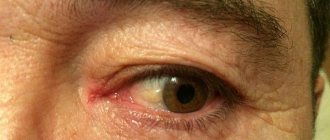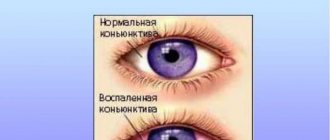Redness of the eyes or conjunctiva is the most common symptom of conjunctivitis. There is no universal cure for this disease. It takes different forms, and the appropriate medicine is selected to treat each. Let's find out how you can remove redness from the eyes with different types of conjunctivitis.
In this article
- Red eyes and conjunctivitis
- How to remove redness from the eyes with bacterial conjunctivitis?
- How to remove redness from the eyes with viral conjunctivitis?
- How to remove redness of the eyes due to allergic conjunctivitis?
- How to relieve redness of the eyes due to chlamydial conjunctivitis?
- General principles of treatment of conjunctivitis
- How to relieve redness of the eyes due to conjunctivitis using folk remedies?
- Why is conjunctivitis dangerous?
Often the conjunctiva turns red after work associated with visual strain, for example, among office workers. In other words, this symptom alone is not enough to make a diagnosis. You can remove redness with almost any solution that has a moisturizing or soothing effect. However, it is not recommended to do this without a doctor's prescription. It is necessary to establish the exact cause of the symptom. After this, it will be possible to prescribe a full course of treatment for the disease. Let's find out how to remove redness from the eyes due to conjunctivitis. To do this, let's look at its main varieties and specific features.
Red eyes and conjunctivitis
You can reduce redness and discomfort with drops based on natural tears. They are called “Artificial tears”. In addition to hyperemia, this drug will eliminate burning, itching and other symptoms. However, redness will reappear if the disease is not treated with antimicrobial, antiviral, antihistamine and other medications. Which drug to choose for treatment? It depends on the cause and form of the pathology.
According to the type of inflammation and the reasons that caused it, conjunctivitis is divided into the following main types:
- bacterial;
- viral;
- chlamydial;
- allergic.
Let us characterize all these diseases in more detail.
How to remove redness from the eyes with bacterial conjunctivitis?
The cause of the development of the disease is the entry into the body of staphylococci, gonococci, streptococci and other bacteria. The inflammation usually affects only one eye, but if left untreated, it spreads to the second. Staphylococcal infection instantly causes redness of the conjunctiva, the eyelids swell, and pus is released from the mucous membrane in large quantities. With pneumococcal infection, in addition to redness, hemorrhages are observed. Numerous red dots appear on the conjunctiva. The patient complains of pain in the eyes in bright light. A thin translucent film forms on the connective membrane. With Pseudomonas aeruginosa inflammation, the mucous membrane becomes very red, pain and burning occur, and lacrimation develops. The diphtheritic form of conjunctivitis is accompanied not only by hyperemia of the mucous membrane, but also by redness and thickening of the eyelids. Plaque appears on the conjunctiva, and when removed, bleeding occurs.
How is bacterial conjunctivitis treated and how to relieve red eyes? After making a diagnosis and determining the type of inflammatory process, the doctor will prescribe Diclofenac, which reduces the severity of inflammation, ointments and drops with antibiotics to kill bacteria, as well as a solution of boric acid to remove mucus and pus. Antibiotics are used until all symptoms disappear completely.
Possible reasons
Irritation of the mucous membrane of the eyes occurs under the influence of negative environmental factors:
- polluted or dry air;
- the presence of substances in the air that cause allergies in humans;
- prolonged exposure to bright light;
- working at a computer or watching TV, using gadgets;
- reading in poor lighting;
- working with small objects;
- lack of sleep.
Irritation can occur due to incorrectly fitted glasses or contact lenses.
How to remove redness from the eyes with viral conjunctivitis?
Adenoviruses, herpes and other viruses can provoke conjunctivitis. The most common diseases in this group are adenoviral and herpetic conjunctivitis. Inflammation caused by adenoviruses is characterized not only by ophthalmological symptoms, but also by signs that worry patients with ARVI: cough, runny nose, headache and throat pain, elevated body temperature, swollen lymph nodes. They are especially pronounced at the beginning of the disease. After a few days, these symptoms are joined by eye hyperemia, burning, lacrimation, photophobia, mucous and purulent discharge. Adenoviral conjunctivitis can be catarrhal, follicular, or film-like. Each of them is treated with antiviral drugs. Medicines that strengthen the immune system are also prescribed. You can remove redness from the eyes using Systane drops. They imitate tear fluid, moisturize the surface of the eyeball, relieve inflammation and the accompanying symptoms.
Herpetic conjunctivitis occurs due to the herpes virus entering the body. Most people are infected with it. It is not possible to remove it. The virus may not appear for a long time. It is activated and begins to multiply when the immune system is weakened. Conjunctivitis caused by herpes is characterized by photophobia, lacrimation, and blepharospasm. Blisters appear on the skin of the eyelids, around the eyes and on the wings of the nose. Redness of the conjunctiva may be mild.
Treatment focuses primarily on strengthening the immune system and blocking the virus with antiviral drugs. Skin rashes are treated with ointments. “Green green” can also be used. Furacilin is prescribed for washing the eyelids and eyes. Hygiene procedures are among the most important. They help prevent the proliferation of viruses and bacteria, remove redness from the eyes and eliminate other signs of pathology.
Tea bags give your face freshness
If you don’t have patches or cucumbers on hand, regular tea bags will come to the rescue. The tea contains caffeine, which has a vasoconstrictor effect and removes darkening around the eyes. The brewed bags should be placed on your eyelids and lie with them for about ten minutes.
- Organic Kitchen “Pu-erh tea bags”, 156 rubles - liquid eye patches the color of strong brewed tea. It will be useful as an express remedy in the fight against teary eyes and as a morning assistant that will refresh the face.
- Etude House fabric mask with green tea extract, 106 rubles - green tea is rich in tannins, which in their effect are similar to the effect of caffeine on the skin. With this mask you can quickly put your face in order if you watched “Pretty Woman” before going to bed and cried a little at the end.
How to remove redness of the eyes due to allergic conjunctivitis?
Profuse lacrimation, burning, itching, redness of the eyes with conjunctivitis are the most obvious signs of the allergic form of this disease. They cause severe discomfort to the patient, which can be eliminated as quickly as possible with the help of moisturizing and soothing drops.
For allergic inflammation, solutions based on artificial tears are most preferable. Such drugs have no contraindications or side effects. After instillation, the patient immediately feels relief. Allergic conjunctivitis usually occurs in spring and summer during the flowering period of plants. As a rule, allergy sufferers are prepared for this and keep the appropriate medications with them.
How to relieve redness of the eyes due to conjunctivitis using folk remedies?
Home treatment should not be an alternative to drug therapy. Folk remedies can act as one of the methods of combating the disease with an integrated approach. Actually, any prescription that you plan to use must be approved by a doctor.
Chamomile has an antibacterial effect. It is sold dried in pharmacies. It is necessary to dilute a spoonful of herbs in a glass of boiling water, cool the broth and make lotions from it. The effectiveness of eliminating dry eyes, redness, itching and burning is shown by the properties of calendula. It should be diluted in hot water and filtered. The resulting solution can be used to rinse your eyelids. Another popular remedy for conjunctivitis is blueberry tea. It is believed that it strengthens the immune system, including local immunity, thereby accelerating the healing process. You need to add the dried berries to a pan of boiling water and cook them for 5 minutes. You can drink tea with honey, but only if there is no fever.
Aloe leaf is used to create compresses. You need to cut the plant or grate it, wrap it in gauze and apply it to your eyelids for 15-20 minutes. Some recipes recommend dropping aloe juice into your eyes. However, it is better to avoid such methods. On the Internet you can find other tips on how to independently eliminate the symptoms of conjunctivitis. Do not resort to them without first consulting a specialist. Moreover, under no circumstances should all these remedies be used to treat children. This can lead to complications.
How to get rid of red eye?
When it finally becomes clear why our eyes turn red in photographs, it’s time to understand what actions to take in order to reduce this unpleasant effect to a minimum.
Using flash
Before you start taking bad shots that you will then have to edit, let's look at options for “saving” photos using the correct camera flash settings.
1. Remove the flash from the optical axis of the lens . This will prevent light that is reflected from the fundus from entering the lens or sensor. A cobra flash raises the flash emitter above the lens, allowing less red light to enter the lens. The method is not available for soap dishes, and is also not always able to eliminate the effect completely. A flash, which is not built-in and is located at arm's length from the camera, will help you completely get rid of red eyes in a photo.
2. Flash redirection . The flash can be directed not at the object itself, but upward, one might say, at the ceiling. This will diffuse the light, minimize shadows and prevent redness from appearing in the eyes. This method is not available for cameras with a built-in flash, or in rooms without a light or even white ceiling. The height should not be too high.
3. Installing a diffuser on the flash . A particularly good option for point-and-shoot cameras, where the flash is fixed and built into the body. It must be covered with a translucent material that transmits light well, but nevertheless scatters it: a plastic bag, thin white paper or fabric will do. Sometimes you can find ready-made devices in specialized stores, but this is rather the exception. If you create a diffuser yourself, then the quality of the material and the number of its layers are selected individually, by eye. This way you will definitely get rid of red eyes, soften hard shadows from the flash using a budget device. However, the disadvantages here are obvious: the flash guide number (operating distance) will decrease, and the mechanism itself is quite difficult to fit into the camera design while maintaining ease of use.
4. Using a reflector . The diffuser mentioned above can be replaced with a device such as a reflector - this is a kind of white ceiling, and we talked about it earlier. The reflector can be homemade, for example, from foil. The light from the flash will be redirected specifically to it. With its help, you will certainly get rid of the unnecessary effect, make soft shadows out of hard ones, and will also be less likely to overexpose the photo due to the uniform dispersion of light. At the same time, it is impossible to use this method on point-and-shoot cameras in almost all cases, and the reflector itself is not easy to fit into the camera design (it makes sense to make it removable). Just like with a diffuser, the maximum operating distance of the flash will be reduced here.
For filming in the studio, flashes with diffusers and reflectors are used - they heat up less and also save energy. But working with them is also somewhat more difficult than, for example, with spotlights.
5. Flash mode with red-eye reduction . Photographic equipment developers have made a breakthrough by creating a special flash mode that is designed to reduce red-eye. The essence of the mode is that before the main flash itself, several or one more preliminary ones are given - it is this bright light that helps to narrow the pupils of the models, preparing the eyes for the main flash. Sometimes, instead of a mode, lamps (LEDs) are used, which illuminate the face and serve as autofocus illumination. Still, with this method, the pupil transmits some part of the light further, to the fundus of the eye, so it is not always possible to completely get rid of the effect. The camera's power consumption will increase noticeably, and the flash itself will take longer to charge. Since there are several pre-flashes before the shutter is released, you may not have time to capture everything you need in the frame, or models who decide that the photo has already been taken may walk out of the frame - keep this in mind when choosing this method.
Why is conjunctivitis dangerous?
The disease itself is not very dangerous. With adequate treatment, complete recovery occurs within a few weeks. But if it is not prescribed on time, the risk of complications increases. Inflammation from the conjunctiva can spread to other structures of the eye, including the cornea. Almost any disease that affects this part of the eyeball is accompanied by deterioration of vision up to its complete loss. This happens rarely, but if the first symptoms of the disease occur, visit your doctor. Depending on its form, conjunctivitis can be treated by a pediatrician and a general practitioner, an allergist or an ophthalmologist. It is better to first consult a general practitioner, who will refer you to the appropriate specialists.










